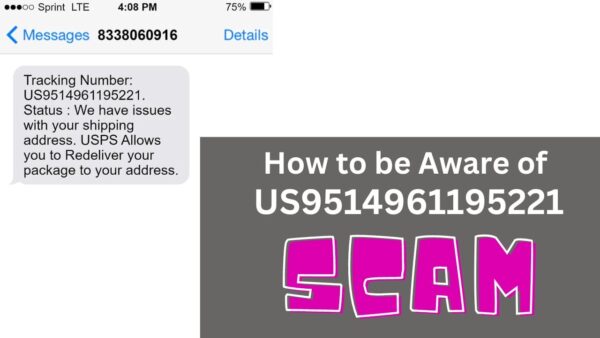
The US9514961195221 Scam: A Deep Dive into Fake Text Messages
Spam alert : us9514961195221 , us9514 , 9611 , 95221 , usps tracking ,++us9514961195221
Introduction
US9514961195221 : scams and fraudulent activities have found new avenues to exploit unsuspecting individuals. One such scam that has gained notoriety in recent times is the US9514961195221 scam, involving fake text messages., we will delve into the details of this scam, shedding light on its modus operandi, red flags, and tips to protect yourself from falling victim.
Read more : https://myfeednews.com/07868802242-who-called-me-in-uk-07868-area-code/
The US9514961195221 Scam
The US9514961195221 scam is a deceptive scheme that primarily targets mobile phone users. It typically begins with the victim receiving a text message from an unknown sender. The message often contains alarming content,
such as a claim that a significant charge has been made to the victim’s bank account or that their social security number has been compromised. To make matters worse, the message includes a link or phone number that the recipient is urged to contact immediately to resolve the issue.
Red Flags to Watch Out For
- Unsolicited Messages: The first and most crucial red flag is receiving an unsolicited text message from an unknown sender. Legitimate organizations, such as banks and government agencies, will not contact you through unsolicited text messages for sensitive matters.
- Urgency and Fear Tactics: Scammers play on emotions by creating a sense of urgency and fear. They might threaten legal action or financial loss to pressure victims into taking immediate action.
- Generic Messages: These scam messages often lack personalization and contain generic information that could apply to anyone. Genuine organizations will use your name and provide specific details when necessary.
- Suspicious Links or Numbers: Be cautious of clicking on any links or calling phone numbers provided in the text. These links may lead to phishing websites or connect you to scammers who will attempt to extract personal information.
- Poor Grammar and Spelling: Scam messages often contain grammatical errors and spelling mistakes. These errors are telltale signs of a scam.
Protecting Yourself from the US9514961195221 Scam
Now that you’re familiar with the red flags associated with the US9514961195221 scam, let’s explore some essential steps to protect yourself:
- Verify the Source: Always verify the authenticity of a message by independently contacting the supposed sender through their official website or phone number. Do not use the contact information provided in the suspicious message.
- Use Antivirus Software: Keep your mobile device protected with up-to-date antivirus and anti-malware software. These programs can help identify and block scam messages.
- Educate Yourself: Stay informed about common scams and their tactics. Knowledge is your best defense against falling victim to fraud.
- Enable Two-Factor Authentication (2FA): Enable 2FA on your accounts whenever possible. This adds an extra layer of security, making it more difficult for scammers to access your accounts.
- Report Scams: If you receive a suspicious text message, report it to your mobile carrier and the Federal Trade Commission (FTC). This can help prevent others from falling victim to the same scam.
- Block Unknown Senders: Set your phone to block messages from unknown senders or enable a spam filter to reduce the chances of receiving scam messages.
Conclusion
The US9514961195221 scam, like many other fraudulent activities, preys on people’s fears and ignorance. By understanding the red flags associated with these fake text messages and taking proactive measures to protect yourself,
you can minimize the risk of falling victim to such scams. Remember, it’s always better to be cautious and verify the authenticity of messages than to hastily respond and potentially compromise your personal information and financial security.
FAQ
- What should I do if I receive a suspicious text message? A . If you receive a text message that appears to be a scam or looks suspicious, it’s important to exercise caution. Do not click on any links, open any attachments, or reply to the message. Instead, delete the message immediately.
- How can I identify a fake text message or scam? A . Fake text messages often contain spelling or grammatical errors, come from unfamiliar or random phone numbers, ask for personal information, or promise unrealistic rewards or prizes. Be wary of messages that seem too good to be true.
- Should I report suspicious text messages? A . Yes, it’s a good idea to report suspicious text messages to your mobile carrier and to the Federal Trade C ommission (FTC) in the United States. US9514961195221 Most carriers have mechanisms in place for reporting spam or scam messages, and the FTC tracks and investigates scams to protect consumers.
- What if I accidentally clicked on a link in a suspicious text message? A . If you clicked on a link in a suspicious text message, it’s important to take immediate action to protect your device and personal information. Disconnect from the internet, run a security scan on your device, change your passwords, and monitor your accounts for any unusual activity.
- How can I prevent receiving fake text messages in the future? A . To reduce the likelihood of receiving fake text messages, you can:
- Enable spam filters on your messaging app or through your mobile carrier.
- Avoid sharing your phone number on public websites or social media platforms.
- Be cautious about providing personal information online.
- Educate yourself and your family members about common scams and how to recognize them.

